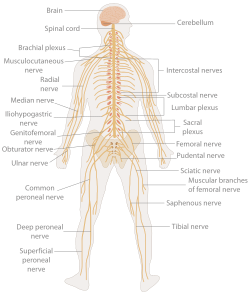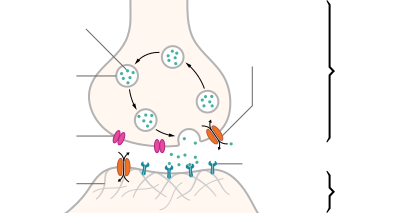Nervous system
| Nervous system | |
|---|---|

The human nervous system.
|
|
| Details | |
| Identifiers | |
| Latin | systema nervosum |
| MeSH | D009420 |
| TA | A14.0.00.000 |
| FMA | 7157 |
|
Anatomical terminology
[]
|
|
| Neuron |
|---|
| Structure of a typical chemical synapse |
|---|
The nervous system is the part of an animal's body that coordinates its actions and transmits signals to and from different parts of its body. Nervous tissue first arose in wormlike organisms about 550 to 600 million years ago. In vertebrate species it consists of two main parts, the central nervous system (CNS) and the peripheral nervous system (PNS). The CNS contains the brain and spinal cord. The PNS consists mainly of nerves, which are enclosed bundles of the long fibers or axons, that connect the CNS to every other part of the body. Nerves that transmit signals from the brain are called motor or efferent nerves, while those nerves that transmit information from the body to the CNS are called sensory or afferent. Most nerves serve both functions and are called mixed nerves. The PNS is divided into a) somatic and b) autonomic nervous system, and c) the enteric nervous system. Somatic nerves mediate voluntary movement. The autonomic nervous system is further subdivided into the sympathetic and the parasympathetic nervous systems. The sympathetic nervous system is activated in cases of emergencies to mobilize energy, while the parasympathetic nervous system is activated when organisms are in a relaxed state. The enteric nervous system functions to control the gastrointestinal system. Both autonomic and enteric nervous systems function involuntarily. Nerves that exit from the cranium are called cranial nerves while those exiting from the spinal cord are called spinal nerves.
At the cellular level, the nervous system is defined by the presence of a special type of cell, called the neuron, also known as a "nerve cell". Neurons have special structures that allow them to send signals rapidly and precisely to other cells. They send these signals in the form of electrochemical waves traveling along thin fibers called axons, which cause chemicals called neurotransmitters to be released at junctions called synapses. A cell that receives a synaptic signal from a neuron may be excited, inhibited, or otherwise modulated. The connections between neurons can form neural circuits and also neural networks that generate an organism's perception of the world and determine its behavior. Along with neurons, the nervous system contains other specialized cells called glial cells (or simply glia), which provide structural and metabolic support.
...
Wikipedia


